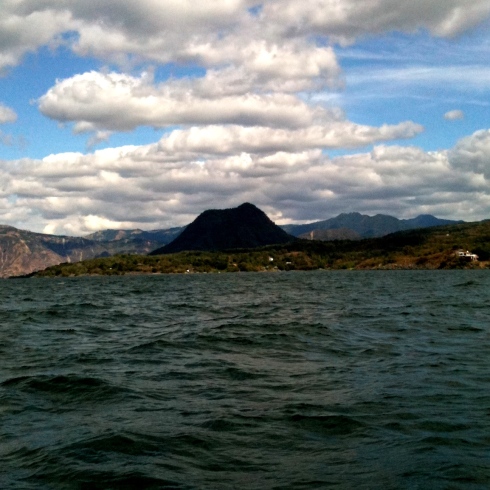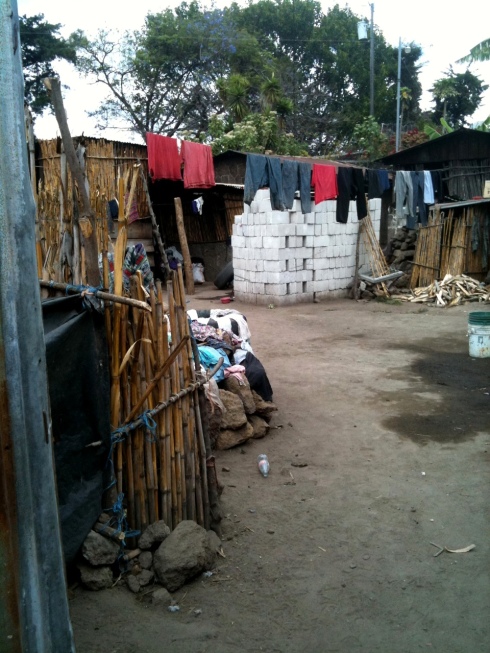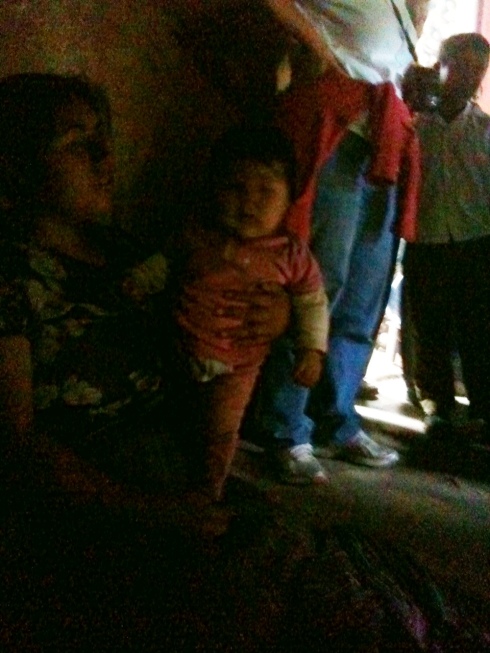I’m sitting on the balcony of our home in Austin, listening to the birds happily sing their symphony to sunshine and spring. The breeze is strong and the air almost sparkles with the freshness of the season. The music of Amy Courts is a perfect soundtrack for the day. I look down at the woven sisal rug that adorns our little outdoor living area, and my heart is whisked away to other birds and other breezes and other fragrances – and to a woman named Eleana.

Cerro de Oro, the Hill of Gold, is a rural community tucked away at the base of a hill on the shore of Lake Atitlan in Guatemala. Legend has it there is an underground palace in the small mount that looks like a sleeping elephant. The Spanish fought and killed to find the treasure in that palace – and it’s rumored the Tz’utujil (Tsoo-tweel) Indians who battled for their lives hid every jewel and every piece of gold in an area of the palace only accessible by a secret underwater cave.

There’s really no reason to visit the legendary Cerro de Oro these days – no attractions, no monuments, no opportunity for tourism. People visit Santiago, which is 30 minutes away. People drive to the ChukMuks, planned communities which are now home to the thousands of people of Panabaj who were displaced when Hurricane Stanley swept through the Western Highlands with force and fury in 2005. But the roads then get smaller, rougher, and less traveled. More people travel on foot from village to village – men with large bundles of wood on their backs or bags of coffee beans for the vendors that will drive along the roads to make their purchases.

The entrance to Cerro de Oro is lined with beautiful trees, and the pavestone road is like hand-hewn artwork. But the welcome is short-lived. The town itself is dry and dusty and windy and worn. The few new homes stand out in the midst of the mud and thatch; most of them built by missionaries wanting to offer a bit of a better life to the families who have so little. Volcanic rock, a reminder of Stanley, is used to create “streets” in the winding neighborhoods. The fragrance of burning wood and chicken coops permeates the air. Only those who know the neighborhoods well can maneuver the dirt trails, livestock, dogs, and trash to visit the people living there.

I had visited Cerro de Oro in October with a team that brought humanitarian aid to Mission Bautista, a tiny church pastored by a man named Tomas. The church, with its mud floor and corregated metal walls and roof, seemed so primitive. But now, after visiting Eleana, the high ceilings and exposed lightbulbs are palatial.
You might consider Eleana one of the fortunate ones in Cerro de Oro. She has a husband. There are so many single moms because of the Guatemalan Civil War, which lasted from 1960 to 1996. The men left and never returned. Some died, and some started new lives with new wives in new places like Mexico, Canada, and the United States. Eleana’s husband stayed. But there is trouble in the household, and she had asked that Tomas and his missionary friends come and pray for her.
Her home is a crude one-room adobe and rock structure with a single window that looks out onto a courtyard of sorts. The courtyard seems to be used as a cooking area. There is an open firepit with an oil drum lid used as a cooktop, baskets with vegetables, and chickens running loose. Clotheslines are strung across the entrance to the courtyard, awaiting the laundry that will be washed either in a creek or in a community well. The door to the home is a tattered piece of cloth. There is no electricity or running water.

Inside, the smoke from another open fire filled the dark room and our lungs. Eleana held her baby girl Yolanda and sat on a woven mat that serves as her sofa during the day and her bed at night. In a quiet voice, she shared her story.
Her husband works, but he spends the money he earns on alcohol. There is little money left for food or clothing. She is unable to work because she has small children to care for. Her baby is sick and won’t get better. Her husband worships idols. She worships God.
She asked us to pray for her husband’s healing, her baby’s healing. To pray for her family. To pray that God would provide. She seemed so helpless, so all alone. Her beautiful round face was weary from the struggle. I wanted so much to simply sit with her and hold that baby so she could stretch her arms a bit – or perhaps take her across Lake Atitlan and pamper her with good food under the tropical trees in Panajachel. I wanted to tell her just how lovely she was to me – and to God. I wanted to let her know I grew up in a home with an alcoholic dad and a mom who couldn’t work – with a dad who hated God and a mom who loved Him. And I knew what it felt like to be alone – and what it felt like to know I was beloved in the midst of the pain.
But I was helpless too.
You see, Eleana spoke Tz’utujil, a Mayan language that’s unique to the people living on the southern shores of Lake Atitlan. She understood no Spanish. To simply pray for her required translation to Spanish and then to her native language. Even saying the name God was a three-step process.
God – Dios – Ajaaw (ah how)
We stumbled through our prayers, speaking in simple phrases that were then translated and translated again. I sat on the mud floor next to her mat, thinking about the words to an Amy Courts song, “Hold You Up.” The lyrics became fresh and new to me in that moment. “If I could speak, you know I’d say the right things…”
Speak – Hablar – Tzijooneem (dzee-hone em)
I turned to my friend Gloria who works for Orphan Outreach (a great ministry that serves the people of Santiago and Cerro de Oro) and whispered, “Can we tell her she’s beautiful? Is that OK? She needs to know she’s beautiful.” She smiled, and whispered my request to Tomas. Quietly, he motioned to Gloria and me as he spoke to Eleana in Tz’utujil. She smiled for the first time – a shy little smile. That small, likely-not-noticed-by-anyone-else moment meant the world to me.
Little – Poco – Tz’iit [tz- eat]
Much – Mucho – K’iy[ k- ēē]
Thanks to Lee Radford of Eagle’s Nest for putting together this short video of our journey to Cerro de Oro. It’s hard for me not to weep when I see the images of Eleana and Yolanda.
[vimeo http://vimeo.com/21331647]
If you’d like to learn more about ministry to the people of Cerro de Oro, you can contact Orphan Outreach. The needs are many there – everything from shoes for the kids to safe homes and medical treatment for the families. Thanks to the amazing people at Eagle’s Nest for setting up our journey across the water, and to Orphan Outreach for allowing us to serve in Santiago and Cerro de Oro.
